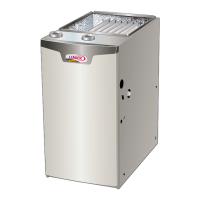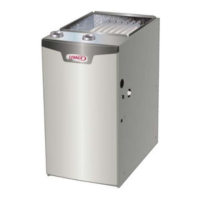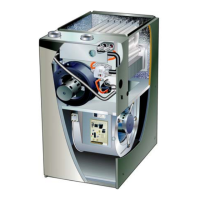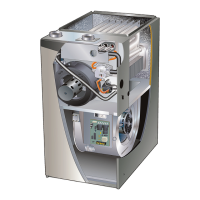Page 33
Details of Exhaust Piping Terminations for Non-Direct
Vent Applications
Exhaust pipes may be routed either horizontally through
an outside wall or vertically through the roof. In attic or
closet installations, vertical termination through the roof
is preferred.
Figures 41 through 42 show typical terminations.
1 - Exhaust piping must terminate straight out or up as
shown. The termination pipe must be sized as listed
in table 15.The specied pipe size ensures proper
velocity required to move the exhaust gases away
from the building.
2 - On eld supplied terminations for side wall exit,
exhaust piping may extend a maximum of 12 inches
(305mm) for 2” PVC and 20 inches (508mm) for 3”
(76mm) PVC beyond the outside wall.
3 - If exhaust piping must be run up a side wall
to position above snow accumulation or other
obstructions, piping must be supported every 24
inches (610mm). When exhaust piping must be run
up an outside wall, any reduction in exhaust pipe
size must be done after the nal elbow.
4 - Distance between exhaust pipe terminations on
multiple furnaces must meet local codes.
Crawl Space and Extended Horizontal Venting
Lennox provides kit 51W18 (USA) kit 15Z70 (Canada) to
install 2” or 3” PVC exhaust piping through the oor joists
and into the crawl space. See gure below. This kit can
also be used as a supplemental drain for installations with
condensate run back in the vent pipe (ie. long horizontal
runs, unconditioned spaces, etc.)
Venting In A Crawl Space
Basement Floor
KIT 51W18
(USA)
KIT 15Z70
(CANADA)
NON-DIRECT VENT ROOF TERMINATION KIT
UNCONDITIONED
ATTIC SPACE
3” (76mm) OR
2” (51mm) PVC
PROVIDE SUPPORT
FOR EXHAUST LINES
12” (305mm)
ABOVE AVE.
SNOW
ACCUMULATION
FIGURE 41
NOTE - Do
tical discharge through an existing unused chimney or stack is required, insert piping
inside
trated. In any exterior portion of chimney, the exhaust vent must be insulated.
STRAIGHT-CUT OR
ANGLE-CUT IN DIRECTION
OF ROOF SLOPE
SHOULDER OF FITTINGS
PROVIDE SUPPORT
OF PIPE ON TOP PLATE
EXTERIOR
PORTION OF
CHIMNEY
INSULATE
TO FORM
SEAL
SHEET
METAL TOP
PLATE
NON-DIRECT VENT APPLICATION
USING EXISTING CHIMNEY
Minimum 12” (305MM)
above chimney top
plate or average snow
accumulation
FIGURE 42
Condensate Piping
This unit is designed for either right- or left-side exit of
condensate piping in upow applications. In horizontal
applications, the condensate trap must extend below the
unit. An 8” service clearance is required for the conden-
sate trap. Refer to gures 43 and 45 for condensate trap
locations. Figure 51 (3/4” drain connection) shows a trap
assembly using 1/2” PVC or 3/4” PVC.
NOTE - If necessary the condensate trap may be installed
up to 5’ away from the furnace. Use PVC pipe to connect
trap to furnace condensate outlet. Piping from furnace
must slope down a minimum of 1/4” per ft. toward trap.
1 - Determine which side condensate piping will exit
the unit, location of trap, eld-provided ttings and
length of PVC pipe required to reach available drain.
2 - For furnaces with a 1/2” drain connection use a 3/8
allen wrench and remove plug (gure 43) from the
cold end header box at the appropriate location on
the side of the unit. Install eld-provided 1/2 NPT
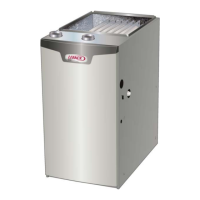
